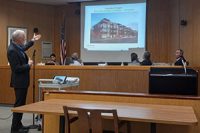Several Residents Remain Skeptical of Mount Pleasant Rezoning Proposal

Several speakers at a public hearing last week criticized Mount Pleasant’s proposed rezoning of its downtown hamlets fearing a concentration of mixed-use developments would alter the town’s character and negatively impact quality of life.
The Sept. 28 hearing on the Draft Generic Environmental Impact Statement (DGEIS) on the form-based zoning code for the hamlets and the town’s Comprehensive Plan update was preceded by a long-awaited presentation from planning consultant Patrick Cleary. He explained the rationale behind the proposed rezoning in the town’s C-NR zoning districts, which are confined to the business hamlets of Thornwood, Hawthorne and Valhalla, and the form-based code, which stresses appearance over specific uses so the town can make its commercial centers more attractive.
Cleary said a key objective is to encourage and make it feasible for the current local commercial property owners to redevelop their properties. Town officials would prefer to entice as many of the current owners of small parcels to retain their land rather than sell to larger outfits.
“We need to encourage local folks to do these developments, not necessarily outside developers to come in and assemble a block to do a larger building,” Clearly said.
One of the skeptical residents was Kensico Road resident Gloria Newman. Newman said her neighborhood currently has a small number of commercial uses and she feared that the proposal could invite builders who would trigger an influx of new residents in areas that are relatively quiet today.
She also expressed concern that a development like the 70 Memorial Plaza project in Pleasantville, which she called “disgusting,” would come to Mount Pleasant.
“Not all the residents, as we can see from the document, are aware of what’s going on in this form-based code,” Newman said. “I would suggest to the town you go and make sure everyone is aware of what’s going on because it would be a tragedy for some people to come back later and then you’re saying, ‘See, we sort of told you.’”
A critical decision facing officials is whether the Town Board approves building heights of three or four stories in the hamlets. Cleary said that if the board agrees to a fourth story, the architecture would call for a top floor that is recessed. However, three-story limits are more likely to attract a larger developer to assemble properties, he said.
Hawthorne resident Jim Russell said development of the hamlets threatens the town’s single-family home districts. He urged the board to update the Comprehensive Plan, which hasn’t been done since 1970, and eliminate consideration of the form-based zoning.
“An integral part of the form-based zoning is bringing in so-called affordable housing, and also what can be called low-income housing, and increasing the population density of these hamlets, and that wasn’t really addressed in this presentation,” Russell said. “I think the impetus for this has come from the (town’s) Industrial Development Agency and not from some groundswell of public opinion within the town.”
Cleary said the zoning proposal would be beneficial to the community.
“By putting the development in the hamlets, we are protecting the residential neighborhoods in the community,” he said.
Conservation Advisory Council Chairman Steven Kavee responded that there is no incentive for a developer to build large quantities of affordable housing, although one of the town’s challenges is to find a way to incorporate workforce units into the housing stock.
Kavee, a supporter of form-based zoning, said it’s a tool to encourage growth in specific areas of town. The town should also be focusing on green building standards.
“The form-based code portion of the Comprehensive Master Plan is one good step that we hope will encourage growth along transportation corridors, increase housing diversity with well-executed design, and most importantly, incorporate green building construction,” he said.
The hearing was adjourned until the Town Board’s next regular meeting on Tuesday, Oct. 12.

Martin has more than 30 years experience covering local news in Westchester and Putnam counties, including a frequent focus on zoning and planning issues. He has been editor-in-chief of The Examiner since its inception in 2007. Read more from Martin’s editor-author bio here. Read Martin’s archived work here: https://www.theexaminernews.com/author/martin-wilbur2007/
